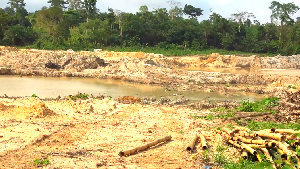The three main players in the energy sector; the Volta River Authority (VRA), Electricity Company of Ghana (ECG) and the Tema Oil Refinery (TOR) are intertwined in conflicts known only to insiders.
While the VRA is accusing the ECG of operating with obsolete equipment, the electricity company is blaming the power producers of overloading the intake transformers, hence the numerous power outages lately.
The Tema Oil Refinery on the other hand has found itself in a mess when after making use of fuel it stored for the VRA, meant to run the Strategic Reserve Plant (SRP), the refinery replaced the used product with the wrong specification.
The VRA, from the beginning of this year, said that it was going to depend on thermal power generation (65% of national requirement) and derive 35% of power from hydro generation.
Investigations this reporter conducted revealed that over the past six weeks, the ECG has been losing power from VRA at the main substation at Tema near TOR. It was detected that the three transformers with 99MVA cannot handle the demand by the ECG for its consumers, especially at the peak period between 19:00 and 22:00 hours GMT.
As a result, the VRA is compelled to install a fourth transformer with 66MVA capacity to complement the earlier three. Aside of this, the VRA is said to be going behind in an attempt to snatch ECG's main customers such as the three steel companies and GHACEM.
The inability of the VRA to provide enough power has led to unofficial load shedding in some major cities at peak period. The electricity company, on their part, is using old and weak transmission lines and transformers, which cannot be depended on. Government recently announced a US$ 75 million package to revamp the ECG nationwide especially Accra, Tema, Kumasi and Takoradi.
The problem between TOR and the VRA is one of disappointment. Very aware that the pattern of rainfall can not be trusted, it positioned itself in readiness by going in for thermal generation of 110 megawatts of power to back up the failing hydro system. Fuel meant for the operation was ordered and stored with the refinery.
When all was set for the project to take off, TOR reportedly used the fuel that was stored in their tanks and so replaced it with a consignment, which was later detected to be unsuitable for running the Strategic Reserve Plant.
It was therefore pumped back to the refinery, and for sometime now the SRP, which is expected to beef up energy from Aboadze and Cote d'Ivoire, has become a white elephant.
TOR itself is fronted with internal problems. The roofs of crude oil tanks 51, 54, and 56 are as dangerous as tank 53, which has collapsed and has remained unattended to ever since.
Investigations revealed that the flexible tubes connected to these tanks to collect rain water from the top into a reservoir before emptying into the separator are choked hence, liquid can not pass through, leaving such water stored in hanging roofs. Contractors are then engaged to pump this water out but in all cases, the contractors could not empty the rooftops, leading to rust.
Interstingly, officials of the Tema Oil Refinery have contracted people to paint the outside of tank 53 with a collapsed hanging roof as reported by this paper last year.
The painting gives it a look to suggest that the tank has been rehabilitated but in reality, the collapsed roof has remained, rendering it useless. If the others, 51, 54 and 56 are not attended to immediately, now that we will be entering the rainy season, their collapse will leave the refinery with no crude oil storage facility.
Our undercover investigation disclosed that tipper trucks were hired to dump heaps of sand onto the crude oil that went waste from the collapsed hanging roof.
The authorities at TOR must, however, be commended for constructing drainages, desilting choked gutters and the almighty American Petroleum Institute (API) system, which is responsible for collection of any liquid drops at the plant. However, a disturbing issue is the rusty nature of pipes and motors that were submerged when the refinery was flooded last year.
For this, we entreat the minister to pay a visit to the plant today and, apart from seeing the rusty pipes and motors at the Movement of Product (MOP), his entourage should get ready to see a lake in the yard of the refinery formed several months ago as a result of a burst fresh water pipe that supplies water to the plant.
Further investigations revealed that suspicions are being raised over the quality of materials that were used in the construction of the US$230 million Residual Fluid Catalytic Cracker (RFCC) and its durability.
General News of Friday, 21 March 2003
Source: GC
Energy Sector On Test
Entertainment











